SpringBoot之oauth2.0学习之服务端配置快速上手
现在第三方登录的例子数见不鲜。其实在这种示例当中,oauth2.0是使用比较多的一种授权登录的标准。oauth2.0也是从oauth1.0升级过来的。那么关于oauth2.0相关的概念及其原理,大家可以参考这篇文章,这篇文章中会有更详细的解释,下来我们直接进入正题。
1.1、gradle依赖
compile('org.springframework.cloud:spring-cloud-starter-oauth2')
compile('org.springframework.cloud:spring-cloud-starter-security')
在这里我直接引入的是spring-cloud的依赖项,这种依赖的jar包更全面一些,这里面的核心基础还是spring-security。这里SpringBoot的版本为2.0.6.REALEASE
1.2、@EnableAuthorizationServer
在这里我着重强调一下这个注解:@EnableAuthorizationServer,这个注解源代码如下:
@Target(ElementType.TYPE)
@Retention(RetentionPolicy.RUNTIME)
@Documented
@Import({AuthorizationServerEndpointsConfiguration.class, AuthorizationServerSecurityConfiguration.class})
public @interface EnableAuthorizationServer {
}
这个注解主要是导入两个配置类,分别是:
AuthorizationServerEndpointsConfiguration,这个配置类主要配置授权端点,获取token的端点。大家就把对应的端点想象成controller即可,在这个controller下开放了若干个@RequestMapping,比如常见的有:/oauth/authorize(授权路径),/oauth/token(获取token)等AuthorizationServerSecurityConfiguration,主要是做spring-security的安全配置,我们可以看一下相关代码:
public class AuthorizationServerSecurityConfiguration extends WebSecurityConfigurerAdapter {
@Autowired
private List<AuthorizationServerConfigurer> configurers = Collections.emptyList();
@Autowired
private ClientDetailsService clientDetailsService;
@Autowired
private AuthorizationServerEndpointsConfiguration endpoints;
@Autowired
public void configure(ClientDetailsServiceConfigurer clientDetails) throws Exception {
for (AuthorizationServerConfigurer configurer : configurers) {
configurer.configure(clientDetails);
}
}
@Override
protected void configure(AuthenticationManagerBuilder auth) throws Exception {
// Over-riding to make sure this.disableLocalConfigureAuthenticationBldr = false
// This will ensure that when this configurer builds the AuthenticationManager it will not attempt
// to find another 'Global' AuthenticationManager in the ApplicationContext (if available),
// and set that as the parent of this 'Local' AuthenticationManager.
// This AuthenticationManager should only be wired up with an AuthenticationProvider
// composed of the ClientDetailsService (wired in this configuration) for authenticating 'clients' only.
}
@Override
protected void configure(HttpSecurity http) throws Exception {
//....省略部分代码
String tokenEndpointPath = handlerMapping.getServletPath("/oauth/token");
String tokenKeyPath = handlerMapping.getServletPath("/oauth/token_key");
String checkTokenPath = handlerMapping.getServletPath("/oauth/check_token");
if (!endpoints.getEndpointsConfigurer().isUserDetailsServiceOverride()) {
UserDetailsService userDetailsService = http.getSharedObject(UserDetailsService.class);
endpoints.getEndpointsConfigurer().userDetailsService(userDetailsService);
}
// @formatter:off
//上述节点的请求需要授权验证
http
.authorizeRequests()
.antMatchers(tokenEndpointPath).fullyAuthenticated()
.antMatchers(tokenKeyPath).access(configurer.getTokenKeyAccess())
.antMatchers(checkTokenPath).access(configurer.getCheckTokenAccess())
.and()
.requestMatchers()
.antMatchers(tokenEndpointPath, tokenKeyPath, checkTokenPath)
.and()
.sessionManagement().sessionCreationPolicy(SessionCreationPolicy.NEVER);
// @formatter:on
http.setSharedObject(ClientDetailsService.class, clientDetailsService);
}
protected void configure(AuthorizationServerSecurityConfigurer oauthServer) throws Exception {
for (AuthorizationServerConfigurer configurer : configurers) {
configurer.configure(oauthServer);
}
}
}
1.2.1、AuthorizationServerConfigurer
这个接口是认证授权配置的核心接口,不过既然是SpringBoot我们就先来看看它怎么帮我们装配的,我们可以在org.springframework.boot.autoconfigure.security.oauth2.authserver这个包下面找到对应配置的Bean:
@Configuration
@ConditionalOnClass(EnableAuthorizationServer.class)
@ConditionalOnMissingBean(AuthorizationServerConfigurer.class)
@ConditionalOnBean(AuthorizationServerEndpointsConfiguration.class)
@EnableConfigurationProperties(AuthorizationServerProperties.class)
public class OAuth2AuthorizationServerConfiguration
extends AuthorizationServerConfigurerAdapter {
//....
@Override
public void configure(ClientDetailsServiceConfigurer clients) throws Exception {
//默认基于内存创建ClientDetails
ClientDetailsServiceBuilder<InMemoryClientDetailsServiceBuilder>.ClientBuilder builder = clients
.inMemory().withClient(this.details.getClientId());
builder.secret(this.details.getClientSecret())
.resourceIds(this.details.getResourceIds().toArray(new String[0]))
.authorizedGrantTypes(
this.details.getAuthorizedGrantTypes().toArray(new String[0]))
.authorities(
AuthorityUtils.authorityListToSet(this.details.getAuthorities())
.toArray(new String[0]))
.scopes(this.details.getScope().toArray(new String[0]));
if (this.details.getAutoApproveScopes() != null) {
builder.autoApprove(
this.details.getAutoApproveScopes().toArray(new String[0]));
}
if (this.details.getAccessTokenValiditySeconds() != null) {
builder.accessTokenValiditySeconds(
this.details.getAccessTokenValiditySeconds());
}
if (this.details.getRefreshTokenValiditySeconds() != null) {
builder.refreshTokenValiditySeconds(
this.details.getRefreshTokenValiditySeconds());
}
if (this.details.getRegisteredRedirectUri() != null) {
builder.redirectUris(
this.details.getRegisteredRedirectUri().toArray(new String[0]));
}
}
@Override
public void configure(AuthorizationServerEndpointsConfigurer endpoints)
throws Exception {
if (this.tokenConverter != null) {
endpoints.accessTokenConverter(this.tokenConverter);
}
if (this.tokenStore != null) {
endpoints.tokenStore(this.tokenStore);
}
if (this.details.getAuthorizedGrantTypes().contains("password")) {
endpoints.authenticationManager(this.authenticationManager);
}
}
@Override
public void configure(AuthorizationServerSecurityConfigurer security)
throws Exception {
security.passwordEncoder(NoOpPasswordEncoder.getInstance());
if (this.properties.getCheckTokenAccess() != null) {
security.checkTokenAccess(this.properties.getCheckTokenAccess());
}
if (this.properties.getTokenKeyAccess() != null) {
security.tokenKeyAccess(this.properties.getTokenKeyAccess());
}
if (this.properties.getRealm() != null) {
security.realm(this.properties.getRealm());
}
}
@Configuration
@ConditionalOnMissingBean(BaseClientDetails.class)
protected static class BaseClientDetailsConfiguration {
private final OAuth2ClientProperties client;
protected BaseClientDetailsConfiguration(OAuth2ClientProperties client) {
this.client = client;
}
/**
由此可知它会寻找security.oauth2.client的配置
*/
@Bean
@ConfigurationProperties(prefix = "security.oauth2.client")
public BaseClientDetails oauth2ClientDetails() {
BaseClientDetails details = new BaseClientDetails();
if (this.client.getClientId() == null) {
this.client.setClientId(UUID.randomUUID().toString());
}
details.setClientId(this.client.getClientId());
details.setClientSecret(this.client.getClientSecret());
details.setAuthorizedGrantTypes(Arrays.asList("authorization_code",
"password", "client_credentials", "implicit", "refresh_token"));
details.setAuthorities(
AuthorityUtils.commaSeparatedStringToAuthorityList("ROLE_USER"));
details.setRegisteredRedirectUri(Collections.<String>emptySet());
return details;
}
}
}
如果没有用spring-boot的用户,可以也可以参考上述的配置方法,自行配置
1.3、application.yml的配置
根据上述代码我们可以知道,springboot通过外部化配置的security.oauth2.client的前缀来配置客户端。那么因此我们不妨在外部化配置文件里做如下配置:
server:
port: 8080
security:
oauth2:
client:
client-id: root
client-secret: root
scope:
- email
- username
- face
spring:
security:
user:
name: root
password: root
roles: ADMIN
这里先做最基本的配置,配置client-id,client-secret,scope。特别注意oauth2.0一定要先经过springsecurity的auth认证,因此需要在这里配置一个内存用户名与密码为root与root
1.4、配置资源服务器
通过资源服务器来保护我们指定的资源,必须在获取授权认证的时候才能访问。在SpringBoot当中,我们可以通过@EnableResourceServer注解来开启此功能。该注解定义如下:
@Target(ElementType.TYPE)
@Retention(RetentionPolicy.RUNTIME)
@Documented
@Import(ResourceServerConfiguration.class)
public @interface EnableResourceServer {
}
我们可以看到这个注解导入了默认的资源配置信息:ResourceServerConfiguration,它的源代码如下:
@Configuration
public class ResourceServerConfiguration extends WebSecurityConfigurerAdapter implements Ordered {
//....
@Override
protected void configure(HttpSecurity http) throws Exception {
ResourceServerSecurityConfigurer resources = new ResourceServerSecurityConfigurer();
ResourceServerTokenServices services = resolveTokenServices();
if (services != null) {
resources.tokenServices(services);
}
else {
if (tokenStore != null) {
resources.tokenStore(tokenStore);
}
else if (endpoints != null) {
resources.tokenStore(endpoints.getEndpointsConfigurer().getTokenStore());
}
}
if (eventPublisher != null) {
resources.eventPublisher(eventPublisher);
}
//配置资源
for (ResourceServerConfigurer configurer : configurers) {
configurer.configure(resources);
}
// @formatter:off
http.authenticationProvider(new AnonymousAuthenticationProvider("default"))
// N.B. exceptionHandling is duplicated in resources.configure() so that
// it works
.exceptionHandling()
.accessDeniedHandler(resources.getAccessDeniedHandler()).and()
.sessionManagement()
.sessionCreationPolicy(SessionCreationPolicy.STATELESS).and()
.csrf().disable();
// @formatter:on
http.apply(resources);
if (endpoints != null) {
// Assume we are in an Authorization Server
http.requestMatcher(new NotOAuthRequestMatcher(endpoints.oauth2EndpointHandlerMapping()));
}
for (ResourceServerConfigurer configurer : configurers) {
// Delegates can add authorizeRequests() here
configurer.configure(http);
}
//如果没有任何配置资源,则所有请求保护
if (configurers.isEmpty()) {
// Add anyRequest() last as a fall back. Spring Security would
// replace an existing anyRequest() matcher with this one, so to
// avoid that we only add it if the user hasn't configured anything.
http.authorizeRequests().anyRequest().authenticated();
}
}
//....
}
在这里主要是配置资源服务器的配置,我们可以得到如下几点信息:
- 资源配置的核心
ResourceServerConfigurer,在这里如果没有任何配置,则所有请求都要进行token认证 TokenStore主要定义了对token的增删改查操作,用于持久化tokenResourceServerTokenServices资源服务的service(服务层),这里主要还是根据token来拿到OAuth2Authentication与OAuth2AccessToken
1.5、完整示例
1.5.1、资源认证配置
@Configuration
@EnableResourceServer
public class ResourceConfigure extends ResourceServerConfigurerAdapter {
@Override
public void configure(HttpSecurity http) throws Exception {
http.csrf().disable().sessionManagement().sessionCreationPolicy(SessionCreationPolicy.IF_REQUIRED)
.and().authorizeRequests().antMatchers("/free/**").permitAll().and()
.authorizeRequests().anyRequest().authenticated()
.and().formLogin().permitAll();//必须认证过后才可以访问
}
}
在这里如果以/free/**请求路径的,都允许直接访问。否则,都必须携带access_token才能访问。
1.5.2 、授权认证配置
@Configuration
public class WebSecurityConfig extends WebSecurityConfigurerAdapter {
@Override
protected void configure(HttpSecurity http) throws Exception {
http.csrf().disable().requestMatchers().anyRequest().and().authorizeRequests()
.antMatchers("/oauth/*").authenticated().and().formLogin().permitAll();
}
}
根据上文所述,AuthorizationServerEndpoint与TokenEndpoint会开放/oauth/authorize与/oauth/token端点,因此我们必须保证访问端点进行授权认证前,通过springsecurity的用户认证,因此在这里配置了/oauth/*
1.5.3、启动类
@SpringBootApplication
@EnableAuthorizationServer
@Controller
public class AuthorizationServer {
@GetMapping("/order")
public ResponseEntity<String> order() {
ResponseEntity<String> responseEntity = new ResponseEntity("order", HttpStatus.OK);
return responseEntity;
}
@GetMapping("/free/test")
public ResponseEntity<String> test() {
ResponseEntity<String> responseEntity = new ResponseEntity("free", HttpStatus.OK);
return responseEntity;
}
public static void main(String[] args) {
SpringApplication.run(AuthorizationServer.class, args);
}
}
1.5.4、访问请求
首先我们通过postman 访问http://localhost:8080/order会得到如下界面:
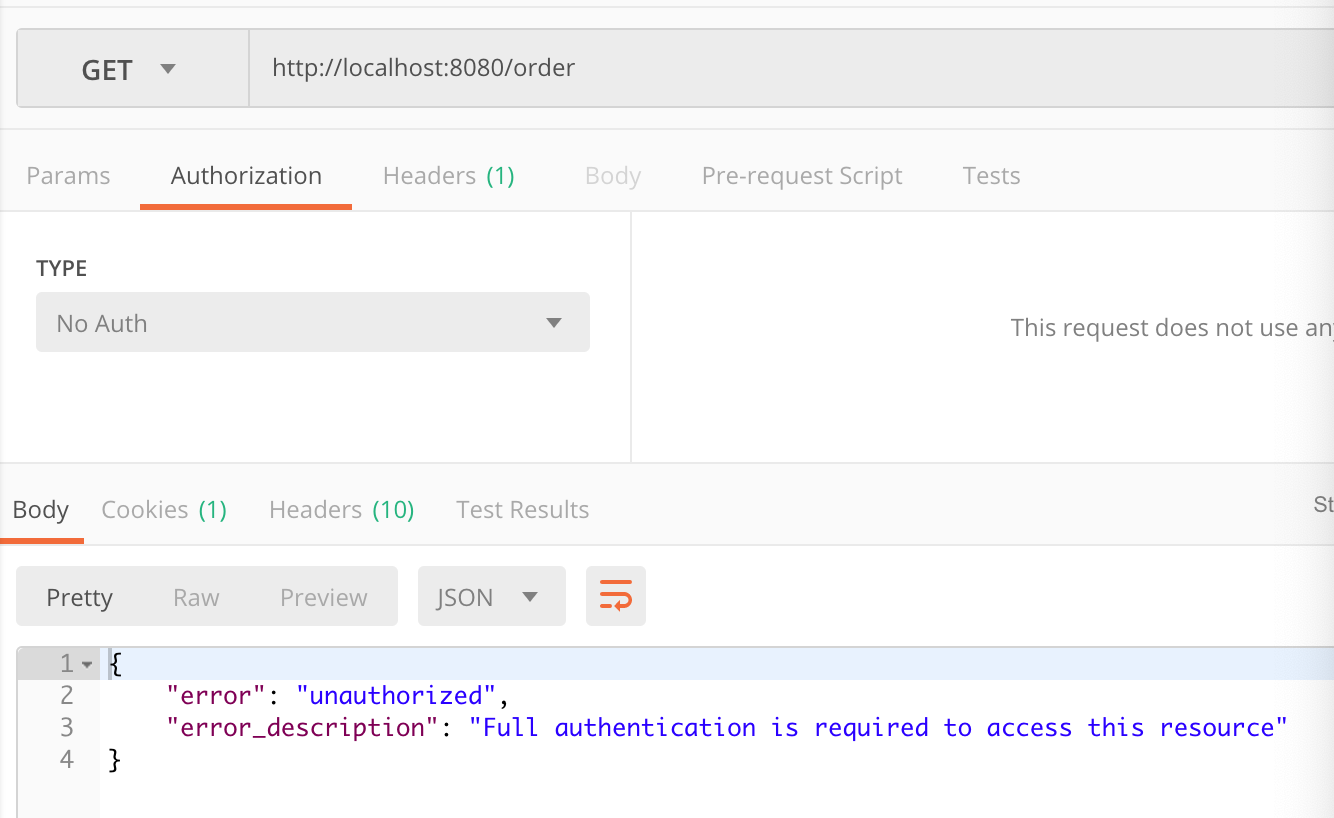
此时我们明显可以看到对应的资源需要携带有效的token才可以访问,那么我们此时要在postman的Authorization进行oauth2.0配置认证。截图如下:
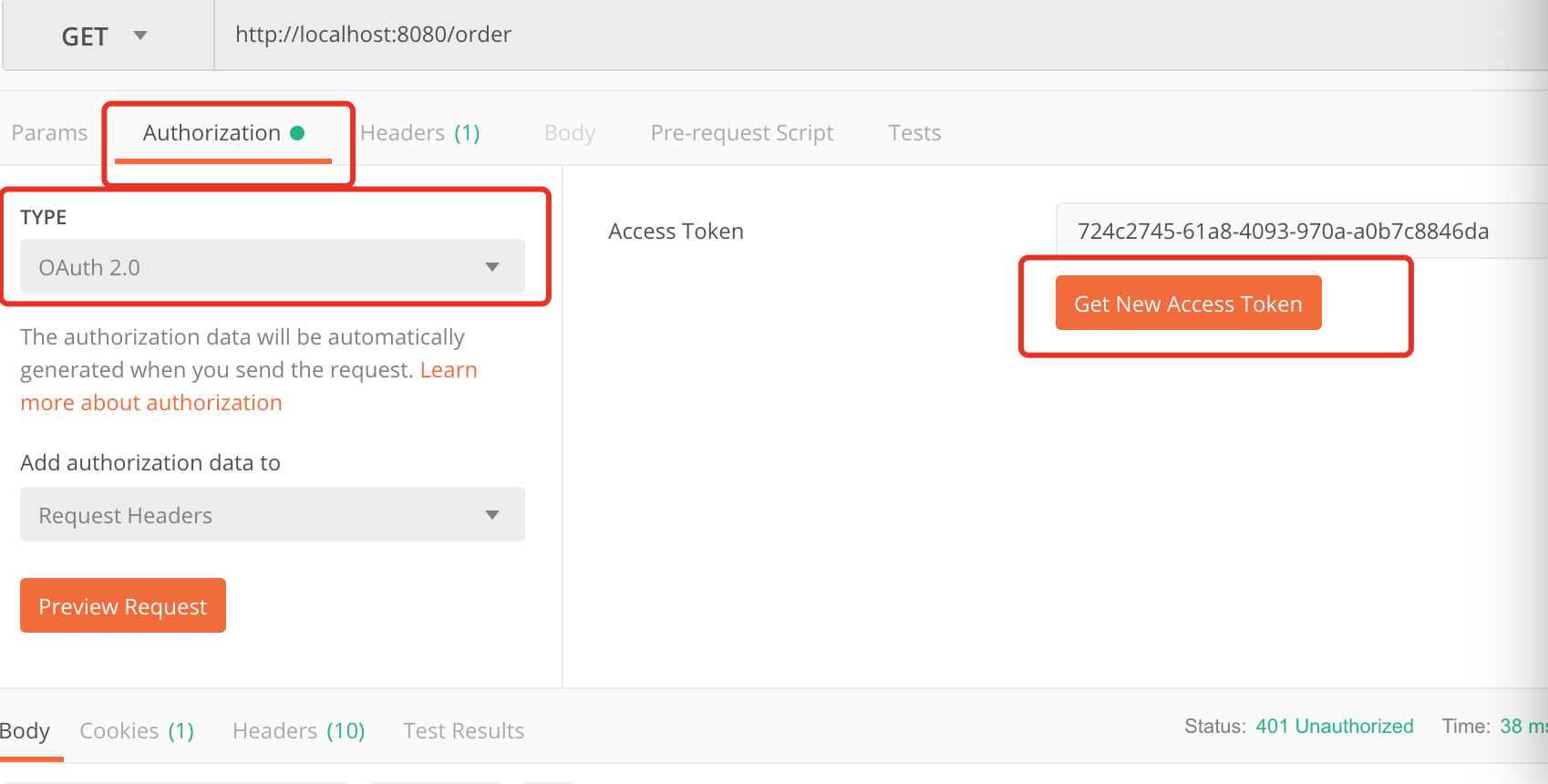
在这里点击Get New Access Token 来从认证服务器获取token,点击后配置如下:
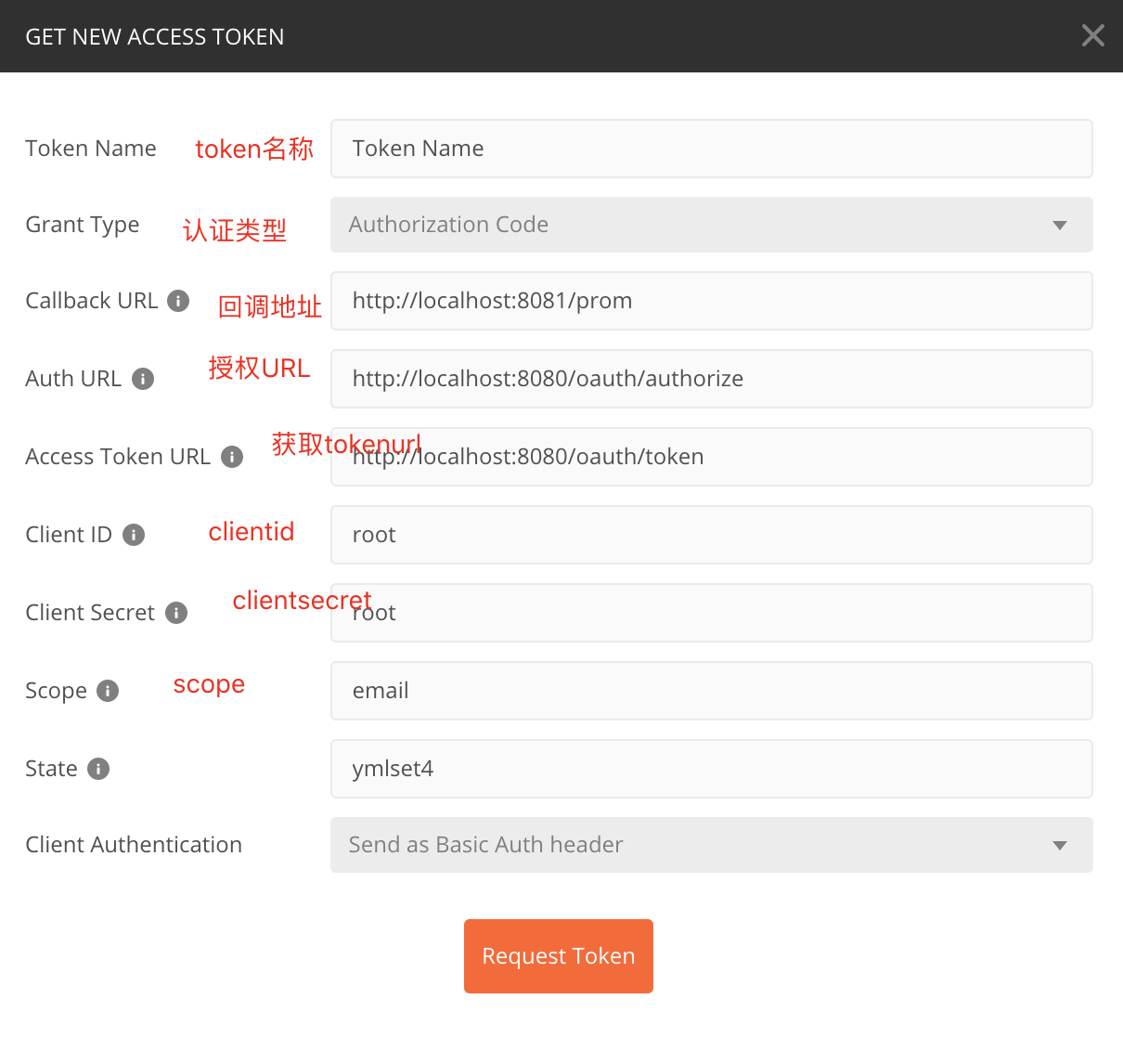
scope配置对应application.yml中的配置信息,这里面可以放置用户的属性信息,比如说昵称 头像 电话等等State代表状态码,设置一个State标志- 回调地址这里必须配置,通过这个地址当同意授权后会返回一个认证的code给我们,我们根据这个code请求token
- 认证地址与获取token的地址请填写,相关Endpoint生成的地址
当经过一连串认证后,我们即可拿到token:
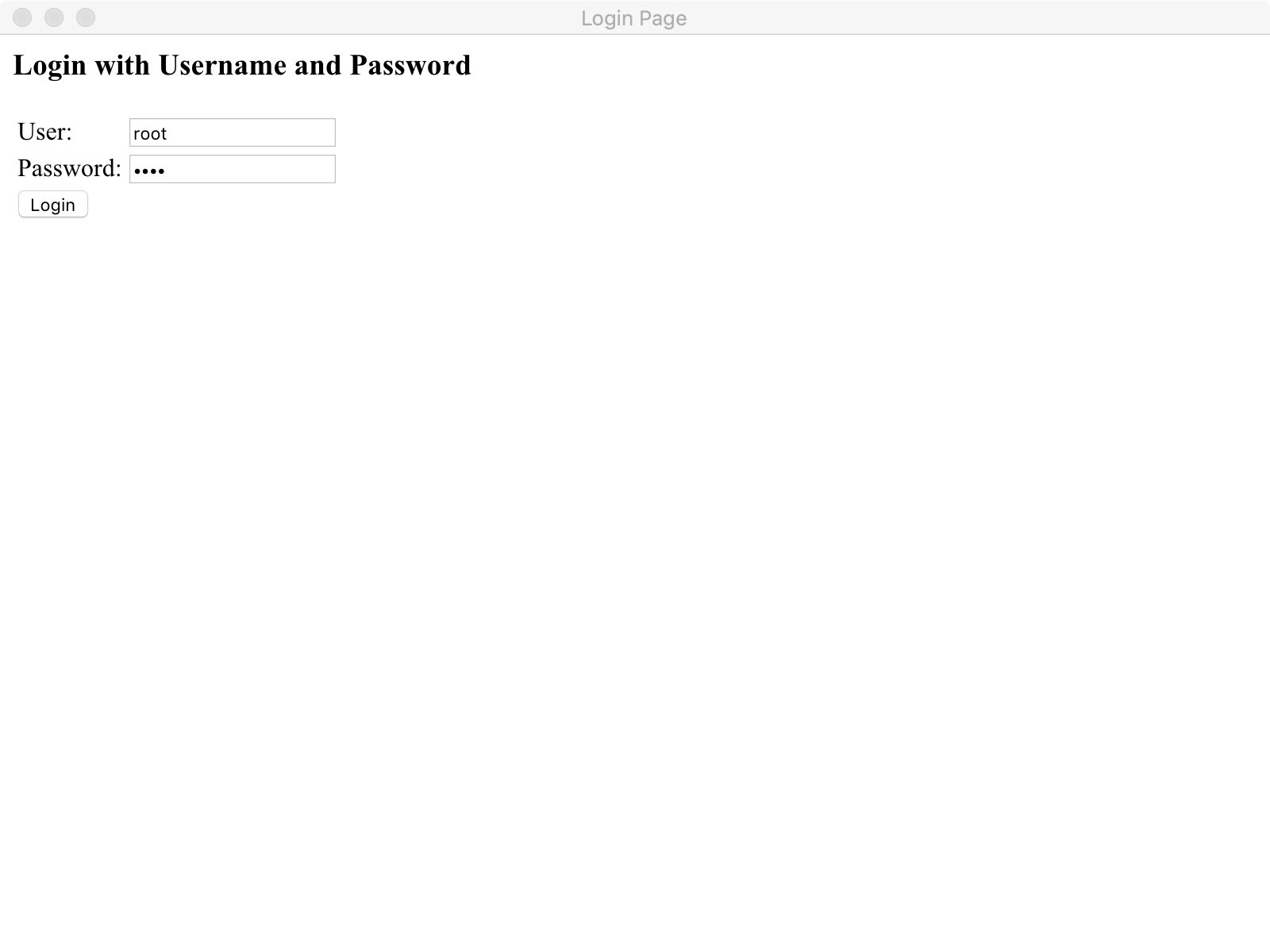
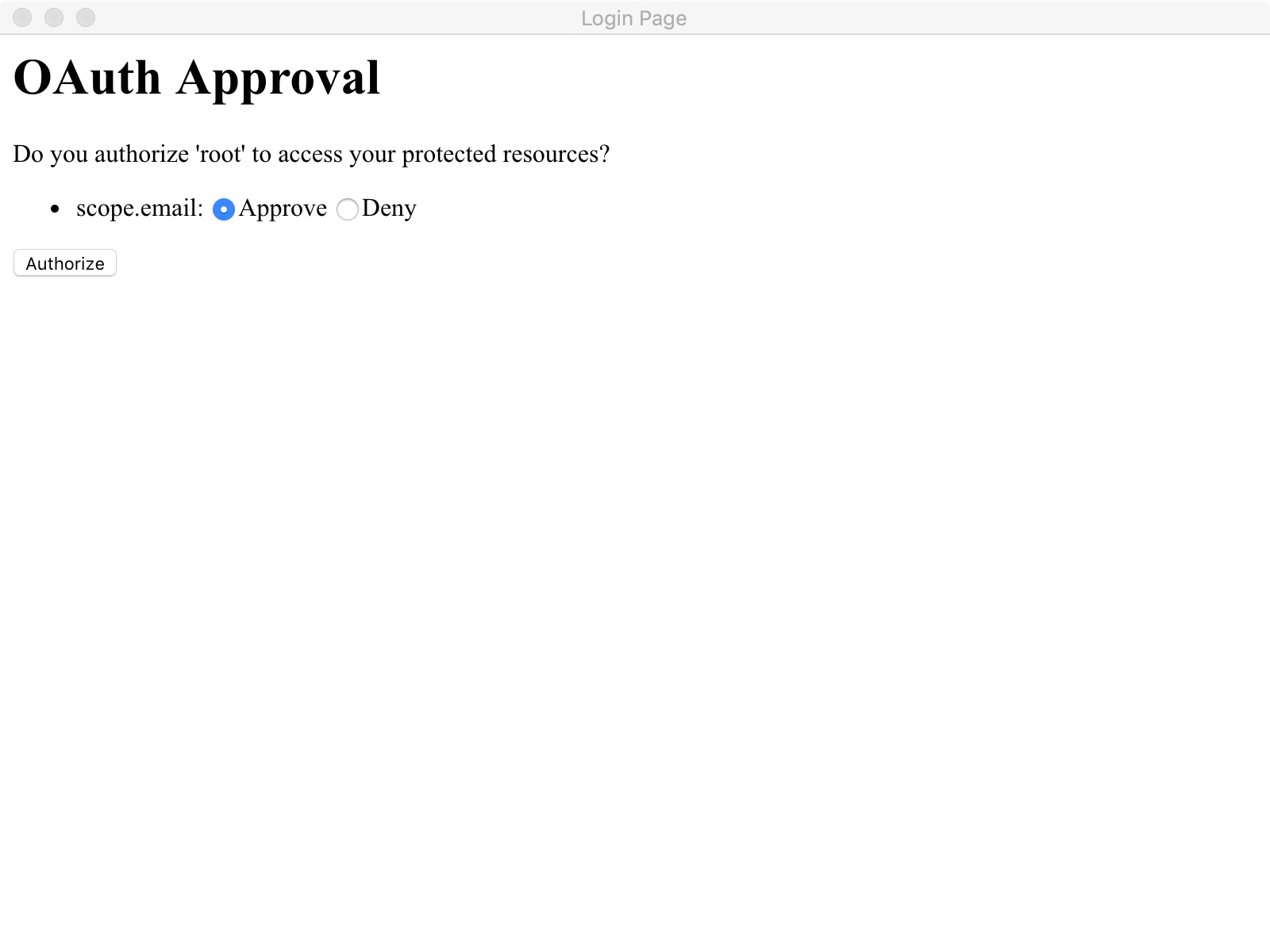
当我们获取到最新的token以后,我们即可访问到对应的请求资源:

SpringBoot之oauth2.0学习之服务端配置快速上手的更多相关文章
- SpringBoot之OAuth2.0学习之客户端快速上手
2.1.@EnableOAuth2Sso 这个注解是为了开启OAuth2.0的sso功能,如果我们配置了WebSecurityConfigurerAdapter,它通过添加身份验证过滤器和身份验证(e ...
- OAuth2.0学习(1-12)开源的OAuth2.0项目和比较
OAuth2.0学习(2-1)OAuth的开源项目 1.开源项目列表 http://www.oschina.net/project/tag/307/oauth?lang=19&sort=t ...
- Spring Cloud Zuul 网关使用与 OAuth2.0 认证授权服务
API 网关的出现的原因是微服务架构的出现,不同的微服务一般会有不同的服务地址,而外部客户端可能需要调用多个服务的接口才能完成一个业务需求,如果让客户端直接与各个微服务通信,会有以下的问题: 客户端会 ...
- Orleans[NET Core 3.1] 学习笔记(三)( 3 )服务端配置
服务端配置 Silo通过SiloHostBuilder和许多补充选项类以编程方式进行配置. Silo配置有几个关键方面: Orleans集群信息 集群提供程序(不知道咋翻译) Silo到Silo和Cl ...
- 【试水CAS-4.0.3】第06节_CAS服务端配置HTTPS
完整版见https://jadyer.github.io/2012/05/30/tomcat-https/ /** * @see CAS服务端配置HTTPS * @see -------------- ...
- Oracle10g客户端链接服务端配置
Oracle10g客户端工具plsql链接服务端配置 Oracle10g客户端工具比如plsql,在网络中链接服务端问题比较多中国菜刀,经常出现很多莫名其妙的问题.实际上不是plsql的配置,问题还是 ...
- mpush 服务端配置 for windows 服务自动运行
mpush 服务端配置 以下安装部分是参照官方的步骤, 一.安装jdk1.8并配置环境变量 示例: http://www.cnblogs.com/endv/p/6439860.html 二.Wind ...
- Rsync同步部署web服务端配置
Rsync同步部署web服务端配置 1,参数详解: -v, --verbose 详细模式输出. -q, --quiet 精简输出模式. -c, --checksum 打开校验开关,强制对文件传输进行校 ...
- day28 rsync服务端配置和客户端
2. rsync守护进程部署方式 客户端---服务端 上厕所 4 rsync守护进程服务端配置: 第一个历程: 下载安装软件 rpm -qa|grep rsync yum install -y rsy ...
随机推荐
- 46-web页面登入前和登入后控制
可以将user存入session中,然后在前端根据能否取到user,来判断是否登入 <c:if test="${user == null }"> <li clas ...
- 微信小程序之----制作视频弹幕
1. 文件目录 使用微信, 长度单位使用 rpx 可以避免不同设备的样式调试问题 经验总结,之前一直使用px ,发现换了测试机就崩了 2. index.wxml页面设置v ...
- 杨其菊201771010134《面向对象程序设计(java)》第四周学习总结
<面向对象程序设计(java)> 第四周学习总结 第一部分:理论知识 1.类与对象 a.类(class)是构造对象的模板或蓝图.由类构造对象的过程称为创建类的实例: java中类声明的格式 ...
- wince sqlite c#
无法找到 PInvoke DLL“SQLite.Interop.084.dll 按下面步骤操作
- Chapter3_操作符_别名机制
Java中的别名机制实际体现的是对于“=”这一类赋值操作符的使用规则和内涵.“=”的实际内涵是指将右边的变量的值(对于基本数据类型而言)或者某一个对象的引用(对于某个具体对象而言)复制到左边的变量名所 ...
- drf8 解析器
解析器的介绍 解析器的作用就是服务端接收客户端传过来的数据,把数据解析成自己想要的数据类型的过程. 本质就是对请求体中的数据进行解析. Accept与ContentType请求头. Accept是告诉 ...
- shell解析my.cnf配置文件
my.cnf配置格式如下 vi my.cnf[client]port=3306socket=/tmp/mysql.socket [mysqld]port=3306server-id=1datadir= ...
- SSM_CRUD新手练习(9)显示分页数据
我们已经做好了用来显示数据的分页模板,现在只需要将我们从后台取出的数据填充好,显示出来. 我们使用<c:forEach>标签循环取出数据,所以需要先导入JSTL标签库 <%@ tag ...
- 修改VS 中的代码编辑颜色-Vs主题修改
有个性的开发人员总是喜欢使用属于的主题和配色方案,它们可以看出开发者的个性,更改它们可以缓解审美疲劳,总之选择一个适合自己的解决方案可能极大的增加自己的编码舒适度. 1. 配色方案的选择和使用 手动修 ...
- Hibernate3.0配置
我的系统Win10(64x),Eclipse jee 2018-09 ,Sql2018版本. 以下是Hibernate3.0配置包 链接:https://pan.baidu.com/s/10Kizby ...
